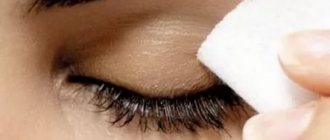Latisse is a modified ophthalmic solution that was previously used as an antiglaucoma drug . Possessing low efficiency, such drops were also characterized by the presence of serious side effects, including accelerated eyelash growth.
But the drops were not discontinued, but on the contrary, the composition was modified, as a result of which Latisse turned from an ophthalmic product into a cosmetic product .
In what cases is the product used?
Latisse drops are used for the diagnosis of hypotrichosis (slow or insufficient eyelash growth).
Stay up to date! The product can also be used in cases of artificial damage to eyelash hairs.
For example, if they are singed or their integrity and growth rate are disrupted due to the application of artificial eyelashes.
There is evidence of the use of such a composition to accelerate the growth of eyebrows or scalp hair.
But in such cases, other specialized drugs are more effective and safe.
Indications
In reviews of the Latisse eyelash growth product, women write about the positive effect. But in what cases should it be used?
There are several reasons. The drug should be used if the eyelashes are:
- Thin, light or sparse.
- They grow slowly and often fall out.
- They require restoration after the extension procedure, after applying glue. The drug is used to strengthen and improve their structure.
If your eyelashes are rapidly falling out, then instead of extensions it is better to use Latisse to strengthen them and stimulate growth.
Before using the product, it is better to consult a specialist, since the cause of poor eyelash condition may be an eye infection or eyelid injury. In this case, the treatment will be different. If there are no diseases, Latisse can be used without fear.
Side effects and contraindications
The main side effect is unwanted hair growth in areas adjacent to the treated areas - this is possible if the drug is not applied carefully.
Note! Also, if even a small amount of solution accidentally but regularly gets into the eyes, the iris may darken.
Allergic reactions may include irritation and dryness of the conjunctiva.
In some cases, temporary visual impairment may occur.
Contraindications to the use of Latisse are:
Reviews of Latisse eyelash product
This drug is quite popular among Russian beauties. Before using the drug, you should read the opinions of those who have already used this drug. Reviews of Latisse indicate that this drug has many advantages:
- It really stimulates hair growth, after which the length of eyelashes increases by 20%. They become thicker and stronger. Growth begins more intensively.
- Eyelashes become darker.
- Hair loss is noticeably reduced.
Several shortcomings of the Latisse product have been identified:
- The effect stops as soon as use of the drug ends.
- If the solution gets on another area of the skin, excessive hair growth begins.
- The remedy is expensive and the course of treatment is long. Therefore, you have to buy a new bottle every month.
- The product must be used regularly, since its effect is not prolonged. After stopping application, eyelashes may begin to crumble and fall out completely.
- High price.
Analogs
Latisse has two close analogues - the drugs Careprost (careprost) and Carelash (karelesh).
Both of them contain the same active substance - bimatoprost .
At the same time, Careprost is low cost , and it should be used with the same frequency as Latisse.
With the same structural features of the composition, Karelesh is a less toxic drug.
Description of the drug
Latisse has a liquid consistency and an almost transparent appearance. The main active ingredient is bimatoprost, a prostaglandin analogue. 1 ml of solution contains 0.3 mg of bimatoprost.
Prostaglandins are substances that can accelerate and improve the functioning of cells. When it comes to eyelashes, prostaglandins prolong the life cycle of the follicle.
Bimatoprost is a fatty acid that, when applied to the growth line, is quickly absorbed, penetrates the hair follicles, provides them with a nutritious environment and activates them.
Additional recommendations for using the product
In most cases, the use of Latisse is not limited to several weeks, since upon completion of the course, the eyelashes regain the same structure as before using the solution.
However, the first positive results can be noticed only after the end of the first month.
Therefore, it is advisable to use such a composition if you are willing to spend a lot of money on it.
If the application procedure was missed on one day the dosage should not be doubled the next day . It is enough to apply the usual amount of composition.
How to use
Reviews of Latisse for eyelash growth suggest that it is better to use the drug at night, before bed.
The sequence of actions is as follows:
- You need to start the process by removing makeup, lenses (if any), as well as washing your face and eyes.
- Wash the hands.
- Take a clean applicator and apply a drop of Latisse solution onto it.
- Apply the preparation to the eyelash line and smoothly distribute it from one corner of the eye to the other.
- The eyelid should become slightly damp, but do not allow the solution to flow past the growth line. Remove excess product with a cotton swab.
- 1 applicator is used once. After use it must be disposed of. To apply Latisse to the other eyelid, use a new applicator.
There are a number of prohibitions that should not be ignored:
- Applicators cannot be used multiple times. They are only disposable.
- Applicators and brushes not included in the kit cannot be used to apply the solution.
- The eyelashes of the lower eyelid cannot be treated with the drug.
- When using the drug, you need to ensure that the bottle spout is sterile and does not come into contact with foreign objects.
In addition to eyelash therapy, Latisse can be used to strengthen eyebrows. It is not necessary to take a new portion of the drug, since the excess that remains after treating the upper eyelid is enough.
Reviews
“Once I used Latisse on the recommendation of a doctor , because after treating demodicosis my eyelashes began to fall out and grow poorly .
The product helped, moreover,
my eyelashes became thicker and more beautiful , although after two months, when I stopped using the product, they regained their normal shape. It’s a pity that the eyelashes did not retain such a beautiful appearance, but on the other hand, such drops only required restoration of hair growth.
And to achieve beauty, you need to turn to other specialists - cosmetologists.”
Oksana Diveeva, Podolsk.
“I decided to try Latisse to increase the volume of my eyelashes, which began to grow poorly after removing artificial eyelashes.
The possibilities allowed me to use the solution for almost six months, during which the structure of the hairs was restored .”
Valeria Gurchin, Pyatigorsk.
What is the effect
The result will become visible within a couple of months with regular use.
The minimum course of treatment is 4 months. Moreover, one bottle lasts for 1 month. At first, you need to apply the drug daily, and as the condition of the eyelashes improves, you can use it in a day or two. Then the consumption of Latisse will also be reduced.
The effect will be observed as long as the drug is used. Many women, after achieving the desired result, continue to use the product once every 3 days to maintain the effect.
Characteristics and properties of the drug
A similar drug, but called Lumigan, was produced by the same company in the form of eye drops. They were intended to reduce intraocular pressure in patients with glaucoma. An improvement in eyelash growth was noted as a side effect as a result of using Lumigan.
The active component of this medicine and Latisse solution is bimatoprost. The claim in many articles on Internet sites that it is obtained from corals and therefore of natural origin is incorrect. Bimatoprost is a synthetic structural analogue of prostaglandin F2-alpha, which is present in the human body, and fully corresponds to its composition, structure and effect.
What are prostaglandins
Substances belonging to the group of prostaglandins are biologically active and, depending on their structure, the amino acid composition of the protein molecule and the effect on the cells of various biological tissues, are divided into several subgroups and classes. They are united by their chemical structure and the principle of synthesis in the body. According to their biochemical composition, prostaglandins are 20-carbon fatty acids formed from polyunsaturated fatty acids. The latter are one of the components of cell membranes. They enter the body with food.
Under the influence of various mediators and neurohormones or as a result of cell damage, arachidonic acid is released. After going through a series of biochemical reactions, it is converted into prostaglandin molecules, which in very small quantities have a stimulating or, conversely, inhibitory effect on the vital processes of cells and tissues. They realize their effect by increasing or decreasing the activity of specific cellular receptors corresponding to specific prostaglandins.
For example, prostaglandins of some classes cause bronchospasm, uterine contractions, and increased intestinal motility, while others have the opposite effect. The human eye contains several types of such receptors. Most of the receptors found are of the FP type. They are located in the trabecular (spongy) network of the eye, ciliary muscle, epithelial layer of the eyeball capsule, and melanocytes of the iris.
Side effects of bimatoprost
The degree of affinity of synthetic prostaglandins with FP receptors of the eye determines the severity of the action of synthetic prostaglandins. The affinity of bimatoprost, contained in Latisse and synthesized not from arachidonic acid, but from its ethanolamide (anandamide), with prostaglandin receptors helps reduce intraocular pressure in glaucoma by increasing the outflow of intraocular fluid. At the same time, its side effects have been identified:
- increased eyelash growth (50%);
- hyperemia (redness) of the conjunctiva and conjunctivitis (in 42%);
- excessive pigmentation of the eyelids (in 1%) and changes in the color of the iris (in 2%);
- dystrophic changes in the cornea (keratopathy);
- inflammatory processes in the iris and ciliary body (iridocyclitis);
- swelling of the yellow spot of the eye (macula), located on the retina; the light beam is focused on it; photoreceptors are concentrated in the macula;
- muscle soreness and flu-like symptoms after the active ingredient enters the nasolacrimal duct with tears and is absorbed into the blood (usually in case of an overdose).
Mechanism for realizing eyelash growth
The first side effect of bimatoprost was successfully used to produce Latisse drops for eyelash growth. The life cycle of the latter consists of three phases:
- anagen, lasting 1 month; During this period, eyelashes lengthen by an average of 0.14 mm per day.
- catagen, or resting phase (transitional); During this period, which lasts about 2 weeks, the final part of the eyelashes thickens and loses pigment, and the division of hair follicle cells stops.
- telogen - the resting phase of the hair follicle lasting an average of 3.5 months; During the telogen phase, gradual loss of eyelashes occurs.
Thus, eyelash growth occurs only during the anagen phase for 1 month. Receptors of hair follicle cells that perceive bimatoprost molecules have not yet been discovered. However, it has been found that Latisse lengthens the duration of anagen as a result of the stimulating effect of the molecules of the synthetic prostaglandin bimatoprost on the cells of the hair follicle and improves the blood supply to the latter.
Before and after 3 months of use
Latisse
The effect of treatment develops gradually, in most patients up to 2 months. Patients should be warned that the effect of the drug is not permanent and a gradual return to baseline is expected after discontinuation of Latisse. In addition, there may be differences in eyelash length, thickness, color intensity, total number of eyelashes, or uneven growth and/or change in direction of eyelash growth.
If the patient forgets to apply Latisse, it is applied at the usual time the next day.
Effect on intraocular pressure (IOP)
Bimatoprost reduces intraocular pressure (IOP) when instilled directly into the conjunctival cavity of patients with elevated IOP. In clinical studies, the use of Latisse was accompanied by a decrease in IOP both in patients with high IOP and in those with normal values, but did not reach clinically significant values. When combined with Latisse and prostaglandin analogues (including bimatoprost in the form of eye drops), used to reduce IOP in patients with intraocular hypertension, the hypotensive effect may be reduced. If the patient is receiving treatment with prostaglandin analogues, consultation with the attending physician and monitoring of intraocular pressure are necessary when prescribing additional therapy with Latisse.
At-risk groups
Caution should be exercised when using the drug in patients with acute inflammatory diseases of the inner membranes of the eyeball, for example, with uveitis, since the use of the drug may aggravate the course of inflammatory phenomena, in patients with aphakia, pseudophakia with rupture of the posterior capsule of the lens, or in patients with risk factors for the development of macular edema.
Iris pigmentation
Increased pigmentation of the iris is possible, especially with dark pigment; this effect may be irreversible. Increased pigmentation of the iris was observed with instillation of eye drops. Changes in pigmentation are associated, first of all, with an increase in melanin content, as well as an increase in the number of melanocytes.
The duration of the pigmentation enhancement effect is unknown. Changes in iris color during treatment may go unnoticed for a period of several months to several years. There is no information on the clinical significance of increased iris pigmentation in the long term. As a rule, when using the drug, brown pigmentation around the pupil spreads concentrically to the periphery of the iris, as a result of which the entire iris or individual sectors acquire a browner color. The use of the drug does not affect the accumulation of pigment on the iris of the eye (nevi and freckles). A significant increase in pigmentation of the iris is not an indication for discontinuation of Latisse.
Eyelid skin pigmentation
Bimatoprost has been reported to cause darkening of the skin of the eyelids and periorbital area.
It is expected that pigmentation may increase throughout the duration of use of the drug Latisse, but in most patients it is reversible and gradually disappears when the drug is discontinued.
Hair growth outside the treatment area
Hair growth is possible on those areas of the skin where the drug was accidentally applied. It is important to apply Latisse only to the skin of the edge of the upper eyelid along the eyelash line using the supplied sterile applicator; Do not allow Latisse to come into contact with your facial skin.
Prevention of microbial contamination of Latisse and applicators
To reduce the risk of eye infection, it is recommended to use Latisse strictly in accordance with the instructions; the tip of the dropper bottle and the applicator brush should not come into contact with any surfaces, and you should not touch them with your fingers. It is necessary to use the supplied sterile applicator only 1 time; after use, the applicator is thrown away, since repeated use of the applicator increases the likelihood of bacterial contamination of the drug and its subsequent infection. Using a contaminated product or applicator may result in an infection. Cases of bacterial keratitis have been reported with the use of multi-dose vials of topical ophthalmic products.
Use when wearing contact lenses
Latisse contains benzalkonium chloride, which can be adsorbed by soft contact lenses, causing eye irritation and discoloration of soft contact lenses. Contact lenses must be removed before using the drug and reinserted no earlier than 15 minutes later.
If any symptoms occur on the part of the visual organ (eye injury, infectious complication, etc.), if there is a sudden decrease in visual acuity, if it is necessary to undergo a planned ophthalmological operation, as well as if undesirable reactions occur, you should consult an ophthalmologist to resolve the issue about the possibility of further treatment with Latisse.
The shelf life of the drug after first opening the bottle is 28 days.
Composition and release form
Initially, this drug, but under a different name, was used to treat glaucoma. But during clinical trials, an interesting side effect was noticed - eyelashes began to grow quickly from the medicinal solution. Moreover, they were so long and fluffy that they often gave the feeling of being glued on.
The drug Latisse is a clear, almost colorless solution, without a distinct odor, which is used for eye drops. The active ingredient of the drug is bimatoprost. The composition also contains a number of auxiliary components - benzalkonium chloride, heptahydrate, hydrochloric and citric acid, as well as sterile water.
The medicine is produced in plastic bottles with a volume of 3 ml. Each bottle is enclosed in an individual cardboard package, along with special applicators, a brush and instructions for use. Each pack contains 60 applicators that make it easy to apply the solution directly to the lash line.
The drug Latisse is a clear, almost colorless solution, without a distinct odor, which is used for eye drops. The active ingredient of the drug is bimatoprost. The composition also contains a number of auxiliary components - benzalkonium chloride, heptahydrate, hydrochloric and citric acid, as well as sterile water.
Latisse eye drops contain the active component Bimatoprost.
The drug is produced in the form of eye drops of 3 and 5 ml. The kit contains an applicator and a brush for using the drug
History of appearance
Age leaves its mark on faces and eyes: the iris turns pale, eyelashes become thinner, shortened, and even fall out, leaving bald spots on the eyelid. But patients who used Lumigan for a long time began to grow healthy, thick, dark and long eyelashes after some time. Pharmacologists were initially discouraged by this fact, because the drops were therapeutic and at the same time had a lot of side effects.
After some time, Allergan returned to Lumigan again and adapted it to the needs of cosmetology, writing impressive instructions. Inexpensive Lumigan was often bought for cosmetic purposes instead of Latisse; as a result, the drug disappeared from public and pharmacy circulation. Today it is a very popular drug with a proven effect of eyelash growth in the following parameters:
- Eyelashes became thicker in 80% of respondents.
- 25% noted a significant increase in eyelash length.
- Noticeable thickening and darkening of hairs in 18% of cases.
Invented and
The drug was patented by the American company Allergan, which gave the world other well-known cosmetic brands such as Juvederm and Botox. Initially, Latisse was not used as a cosmetic product, but was actively used for the treatment of glaucoma, it also had a different name - Lumigan.
Patients who took Lumigan for a long time for the treatment of intraocular pressure noticed an amazing feature: their eyelashes became significantly thicker, thicker and longer, and they also changed color by several tones and became noticeably darker.
Allergan has redesigned the drug, refocusing it solely on improving the quality characteristics of eyelashes, namely increasing their volume and length.
Advantages of Latisse:
- A quick visual effect is achieved after 14 days of intensive use
- Easy to use, just a single application at night is enough
- Safe and hypoallergenic
- Complex effect: enhancing growth in thickness and length, as well as giving a rich black color.
Latisse is indicated for people suffering from eyelash growth deficiency. In medical terms, this disease is called hypotrichosis.











